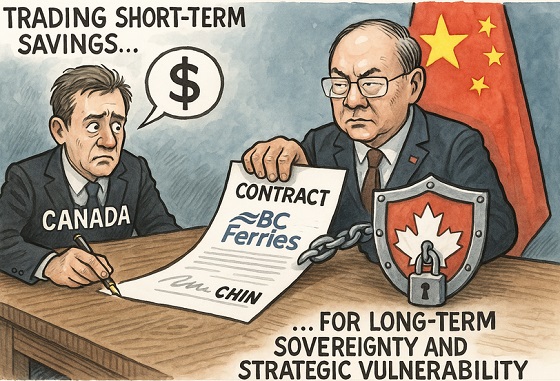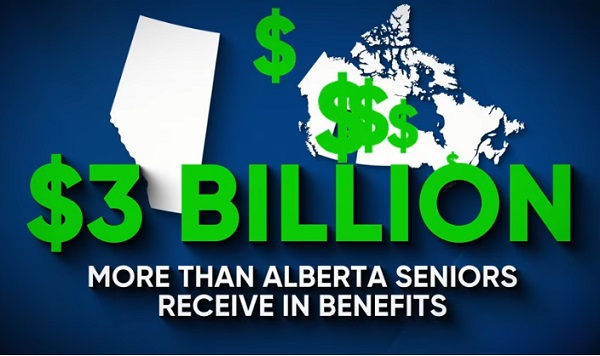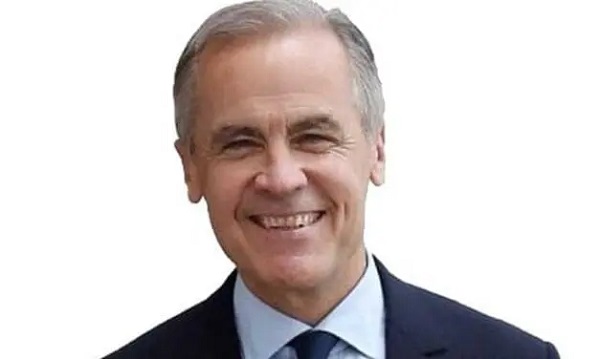Frontier Centre for Public Policy
The tale of two teachers

From the Frontier Centre for Public Policy
By Jim McMurtry
Some have criticized me for stating that the good, as well as the bad, of residential schools should be recognized. I stand by that statement…. Others have criticized me for stating that the Truth and Reconciliation Report was not as balanced as it should be. I stand by that statement as well.
At L.A. Matheson, a high school in Surrey, B.C., a poster in Annie Ohana’s classroom suggests society is too moralistic about sex work, the quote coming from an avowed Satanist. National Post writer Jamie Sarkonak described her classroom in this way: “The walls are covered with Social Justice posters. Some of them sloganeer about ‘decolonization,’ others ‘inflame racial politics.’” Ohana drapes herself in a Pride flag and speaks openly of her pansexuality as well as her subscription to wokeism, identity politics, Social Justice, and DEI.
In March Ohana appeared on CTV after being roundly criticized on X by an Ottawa teacher, Chanel Pfahl, the latter chased out of the profession a few years ago for questioning Critical Race Theory. Ohana said that Pfahl “seems to be making a lot of assumptions that were simply based on misinformation, lies, and in fact, puts myself and other teachers and students and my community in danger.” She also argued she was teaching about “critical thinking” and creating “empowered citizens that can speak up for themselves.” A Canadian flag hangs forlornly in her classroom, atop it is scrawled, “No pride in genocide.”
So far, she has faced no direct consequences for her political position or trying to indoctrinate her students. Indeed, she has won three teaching awards.
I, on the other hand, was walked out of my classroom and career for suggesting the only thing buried in Kamloops was the truth. In the eyes of my employer, I had put students and the community in danger by saying students who died while enrolled at a residential school did so from disease and not murder.
Northrop Frye wrote in The Great Code that the aim is “to see what the subject means, not to accept or reject it.” There is nothing wrong with the teaching of either me or Ohana as long as we are not steering students toward belief. In a 100-page investigation report on my teaching, an assistant superintendent of the Abbotsford School District wrote:
It in my view cannot be overemphasized that Mr. McMurtry having no knowledge of his students and more particularly whether any of these students had Indigenous descent in making his comments that provoked a strong student response and which was contrary to the school’s message of condolences and reconciliation. Regardless of his intent he left students with the impression some or all the deaths could be contributed to ‘natural causes’ and that the deaths could not be called murder or cultural genocide.
My fault was that I didn’t promote a “message of condolences and reconciliation.” Not only was this message never communicated to teachers, the message runs counter to the educational aim of seeing what a subject means. The message is also that the deaths of at least some Indian residential school children were attributable to murder, for which there is still no evidence.
Senator Lynn Beyak was the first prominent Canadian to wade into the increasingly turbulent waters of Indian residential schools. Labelled a racist and facing the prospect of ejection from the Senate, she retired in 2021 from her senate position but not from her convictions.
Some have criticized me for stating that the good, as well as the bad, of residential schools should be recognized. I stand by that statement…. Others have criticized me for stating that the Truth and Reconciliation Report was not as balanced as it should be. I stand by that statement as well.
George Orwell wrote in 1945 in an introduction to Animal Farm, “At any given moment there is an orthodoxy, a body of ideas of which it is assumed that all right-thinking people will accept without question. It is not exactly forbidden to say this, that or the other, but it is ‘not done’ to say it.” Queen’s law professor Bruce Pardy wrote last year: “A new standard of practice is emerging for Canadian professionals: be woke, be quiet, or be accused of professional misconduct.”
Annie Ohana is a better approximation of that mythically average teacher than I. Most teachers appear woke or know enough to be quiet and go along, standing for land acknowledgments, using individualized pronouns with students, speaking of gender identity and sexual orientation, distinguishing students based on race, reading Social Justice books over literary classics, and accepting revisionist history. They go to school wearing the right colour for the occasion: rainbow, pink, orange, red, or black. At staff meetings they are woke and quiet.
I am an avatar of Lynn Beyak, standing outside the orthodoxy and condemned by “all right-thinking people.” Our issue is also the same. Indian residential schools were not the genocidal project that federal members of parliament voted as a genocide on October 27, 2022.
The Truth and Reconciliation Commission, headed by two Indigenous men and a woman married to an Indigenous man, travelled for six years across Canada, and heard from 6000 former students. The Commission’s bias was evident in its final report:
Physical genocide is the mass killing of the members of a targeted group, and biological genocide is the destruction of the group’s reproductive capacity. Cultural genocide is the destruction of those structures and practices that allow the group to continue as a group. States that engage in cultural genocide set out to destroy the political and social institutions of the targeted group. Land is seized, and populations are forcibly transferred and their movement is restricted. Languages are banned. Spiritual leaders are persecuted, spiritual practices are forbidden, and objects of spiritual value are confiscated and destroyed. And, most significantly to the issue at hand, families are disrupted to prevent the transmission of cultural values and identity from one generation to the next. In its dealing with Aboriginal people, Canada did all these things.
What the final report does not mention is:
o the educational value of the schools;
o the alternative was no education at all in remote areas where a day school was not feasible;
o that both Indigenous chiefs and parents saw them as a treaty right and petitioned to keep them open into the sixties;
o that parents had to apply to send their children to residential schools;
o that the mandatory attendance which began in 1920 was to go to school (one-third going to day school, one-third to residential school, and one-third never going to any school);
o that the schools took in orphans and served as a refuge for children and in some cases adults who were abused on the reserve or without the necessities of life; and
o that many former students testified their time there was the happiest in their lives.
My natural allegiance is to fellow teachers, and I don’t doubt that Annie Ohana and others within the Critical Social Justice educational movement teach their students about critical thinking and create empowered citizens that can speak up for themselves. However, such critical thinking should also be directed against the orthodoxy these teachers are imposing on captive groups of students. As well, if their students are indeed empowered citizens, they should come to their own conclusions, no matter the ideological perspective of their teacher.
Jim McMurtry, PhD, was formerly a principal of Neuchâtel Junior College in Switzerland and a college lecturer, but mostly he was a teacher. He lives in Surrey, B.C.
armed forces
Canada’s Military Can’t Be Fixed With Cash Alone

From the Frontier Centre for Public Policy
By Lt. Gen. (Ret.) Michel Maisonneuve
Canada’s military is broken, and unless Ottawa backs its spending with real reform, we’re just playing politics with national security
Prime Minister Mark Carney’s surprise pledge to meet NATO’s defence spending target is long overdue, but without real reform, leadership and a shift away from bureaucracy and social experimentation, it risks falling short of what the moment demands.
Canada committed in 2014 to spend two per cent of its gross national product on defence—a NATO target meant to ensure collective security and more equitable burden-sharing. We never made it past 1.37 per cent, drawing criticism from allies and, in my view, breaching our obligation. Now, the prime minister says we’ll hit the target by the end of fiscal year 2025-26. That’s welcome news, but it comes with serious challenges.
Reaching the two per cent was always possible. It just required political courage. The announced $9 billion in new defence spending shows intent, and Carney’s remarks about protecting Canadians are encouraging. But the reality is our military readiness is at a breaking point. With global instability rising—including conflicts in Ukraine and the Middle East—Canada’s ability to defend its territory or contribute meaningfully to NATO is under scrutiny. Less than half of our army vehicles, ships and aircraft are currently operational.
I’m told the Treasury Board has already approved the new funds, making this more than just political spin. Much of the money appears to be going where it’s most needed: personnel. Pay and benefit increases for serving members should help with retention, and bonuses for re-enlistment are reportedly being considered. Recruiting and civilian staffing will also get a boost, though I question adding more to an already bloated public service. Reserves and cadet programs weren’t mentioned but they also need attention.
Equipment upgrades are just as urgent. A new procurement agency is planned, overseen by a secretary of state—hopefully with members in uniform involved. In the meantime, accelerating existing projects is a good way to ensure the money flows quickly. Restocking ammunition is a priority. Buying Canadian and diversifying suppliers makes sense. The Business Council of Canada has signalled its support for a national defence industrial strategy. That’s encouraging, but none of it will matter without follow-through.
Infrastructure is also in dire shape. Bases, housing, training facilities and armouries are in disrepair. Rebuilding these will not only help operations but also improve recruitment and retention. So will improved training, including more sea days, flying hours and field operations.
All of this looks promising on paper, but if the Department of National Defence can’t spend funds effectively, it won’t matter. Around $1 billion a year typically lapses due to missing project staff and excessive bureaucracy. As one colleague warned, “implementation [of the program] … must occur as a whole-of-government activity, with trust-based partnerships across industry and academe, or else it will fail.”
The defence budget also remains discretionary. Unlike health transfers or old age security, which are legally entrenched, defence funding can be cut at will. That creates instability for military suppliers and risks turning long-term procurement into a political football. The new funds must be protected from short-term fiscal pressure and partisan meddling.
One more concern: culture. If Canada is serious about rebuilding its military, we must move past performative diversity policies and return to a warrior ethos. That means recruiting the best men and women based on merit, instilling discipline and honour, and giving them the tools to fight and, if necessary, make the ultimate sacrifice. The military must reflect Canadian values, but it is not a place for social experimentation or reduced standards.
Finally, the announcement came without a federal budget or fiscal roadmap. Canada’s deficits continue to grow. Taxpayers deserve transparency. What trade-offs will be required to fund this? If this plan is just a last-minute attempt to appease U.S. President Donald Trump ahead of the G7 or our NATO allies at next month’s summit, it won’t stand the test of time.
Canada has the resources, talent and standing to be a serious middle power. But only action—not announcements—will prove whether we truly intend to be one.
The NATO summit is over, and Canada was barely at the table. With global threats rising, Lt. Gen. (Ret.) Michel Maisonneuve joins David Leis to ask: How do we rebuild our national defence—and why does it matter to every Canadian? Because this isn’t just about security. It’s about our economy, our identity, and whether Canada remains sovereign—or becomes the 51st state.
Michel Maisonneuve is a retired lieutenant-general who served 45 years in uniform. He is a senior fellow at the Frontier Centre for Public Policy and author of In Defence of Canada: Reflections of a Patriot (2024).
Business
BC Ferries And Beijing: A Case Study In Policy Blindness

From the Frontier Centre for Public Policy
Scott McGregor warns BC Ferries’ contract with a Chinese state-owned shipbuilder reveals Canada’s failure to align procurement with national security. It is trading short-term savings for long-term sovereignty and strategic vulnerability.
BC Ferries’ recent decision to award the construction of four new vessels to China Merchants Industry (Weihai), a state-owned shipyard under the Chinese Communist Party (CCP), is a cautionary tale of strategic policy failure. While framed as a cost-effective solution to replace aging vessels, the agreement reveals a more critical issue: Canada’s persistent failure to align vital infrastructure procurement with national security and economic resilience.
The situation goes beyond transportation. It is a governance failure at the intersection of trade, security, and sovereignty.
Outsourcing Sovereignty
China Merchants Industry is part of a sprawling state-owned conglomerate, closely connected to the CCP. It is not merely a commercial player; it is a geopolitical actor. In China, these organizations thrive on a unique blend of state subsidies, long-term strategic direction, and complex corporate structures that often operate in the shadows. This combination grants them a significant competitive edge, allowing them to navigate the business landscape with an advantage that many try to replicate but few can match.
The same firms supplying ferries to BC are also building warships for the People’s Liberation Army Navy. That alone should give pause.
Yet BC Ferries, under provincial oversight, proceeded without meaningful scrutiny of these risks. No Canadian shipyards submitted bids due to capacity constraints and a lack of strategic investment. But choosing a Chinese state-owned enterprise by default is not a neutral act. It is the consequence of neglecting industrial policy.
Hybrid Risk, Not Just Hybrid Propulsion
China’s dominance in shipbuilding, now over 60% of global orders, has not occurred by chance. It is the result of state-driven market distortion, designed to entrench foreign dependence on Chinese industrial capacity.
Once that dependency forms, Beijing holds leverage. It can slow parts shipments, withhold technical updates, or retaliate economically in response to diplomatic friction. This is not speculative; it has already happened in sectors such as canola, critical minerals, and telecommunications.
Ordering a ferry, on its face, might seem apolitical. But if the shipbuilder is state-owned, its obligations to the CCP outweigh any commercial contract. That is the nature of hybrid threats to security: they appear benign until they are not.
Hybrid warfare combines conventional military force with non-military tactics (such as cyber attacks, disinformation, economic coercion, and the use of state-owned enterprises) to undermine a target country’s stability, influence decisions, or gain strategic control without resorting to open conflict. It exploits legal grey zones and democratic weaknesses, making threats appear benign until they’ve done lasting damage.
A Policy Void, Not Just a Procurement Gap
Ottawa designed its National Shipbuilding Strategy to rebuild Canadian capability, but it has failed to scale quickly enough. The provinces, including British Columbia, have been left to procure vessels without the tools or frameworks to evaluate foreign strategic risk. Provincial procurement rules treat a state-owned bidder the same as a private one. That is no longer defensible.
Canada must close this gap through deliberate, security-informed policy. Three steps are essential for the task:
Ottawa should mandate National Security reviews for critical infrastructure contracts. Any procurement involving foreign state-owned enterprises must trigger a formal security and economic resilience assessment. This should apply at the federal and provincial levels.
Secondly, when necessary, Canada should enhance its domestic industrial capabilities through strategic investments. Canada cannot claim to be powerless when there are no local bids available. Federal and provincial governments could collaborate to invest in scalable civilian shipbuilding, in addition to military contracts. Otherwise, we risk becoming repeatedly dependent on external sources.
Canada should enhance Crown oversight by implementing intelligence-led risk frameworks. This means that agencies, such as BC Ferries, must develop procurement protocols that are informed by threat intelligence rather than just cost analysis. It also involves incorporating security and foreign interference risk indicators into their Requests for Proposals (RFPs).
The Cost of Strategic Amnesia
The central point here is not only about China; it is primarily about Canada. The country needs more strategic foresight. If we cannot align our economic decisions with our fundamental security posture, we will likely continue to cede control of our critical systems, whether in transportation, healthcare, mining, or telecommunications, to adversarial regimes. That is a textbook vulnerability in the era of hybrid warfare.
BC Ferries may have saved money today. But without urgent policy reform, the long-term cost will be paid in diminished sovereignty, reduced resilience, and an emboldened adversary with one more lever inside our critical infrastructure.
Scott McGregor is a senior security advisor to the Council on Countering Hybrid Warfare and Managing Partner at Close Hold Intelligence Consulting Ltd.
-

 armed forces1 day ago
armed forces1 day agoCanada’s Military Can’t Be Fixed With Cash Alone
-

 Business1 day ago
Business1 day agoCanada’s loyalty to globalism is bleeding our economy dry
-

 Alberta1 day ago
Alberta1 day agoAlberta Next: Alberta Pension Plan
-

 Alberta1 day ago
Alberta1 day agoCOVID mandates protester in Canada released on bail after over 2 years in jail
-

 International1 day ago
International1 day agoTrump transportation secretary tells governors to remove ‘rainbow crosswalks’
-

 Crime2 days ago
Crime2 days agoProject Sleeping Giant: Inside the Chinese Mercantile Machine Linking Beijing’s Underground Banks and the Sinaloa Cartel
-

 Alberta2 days ago
Alberta2 days agoAlberta uncorks new rules for liquor and cannabis
-

 Business1 day ago
Business1 day agoCarney’s spending makes Trudeau look like a cheapskate






